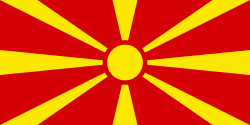Lažani
Lažani (Лажани, Llazhan) is a village located in a lowland area in the municipality of Dolneni, North Macedonia.
Lažani traditionally was inhabited by a Macedonian Muslim (Torbeš) population that speaks the Macedonian language. During the 1960s, Slavic Muslims from Sandžak, known as Sandžakli settling in Debrešte were not well received by the local population which forced them to move to neighboring villages, mainly to Lažani where their numbers are high. Muslim Albanians from the sub-region of Pešter in Sandžak also settled in Lažani and number 30 households with some families bearing the surname Shkreli. The village in the 21st century has a mixed population consisting of Macedonian Muslims (Torbeš), Orthodox Macedonians, Bosniaks and Muslim Albanians containing 300 households amidst a population of around 2000 people. Intermarriage between Muslim Albanians and Bosniaks occurs in the village. Macedonian Muslims from Lažani refer to the surrounding Christian population as Makedonci (Macedonians) and those Orthodox Macedonians refer to them as Turci (Turks) due to they being Muslims.
According to the 2021 census, the village had a total of 1.755 inhabitants. Ethnic groups in the village include:
* Bosniaks 901
* Turks 377
* Macedonians 264
* Albanians 153
* Others 60
Lažani traditionally was inhabited by a Macedonian Muslim (Torbeš) population that speaks the Macedonian language. During the 1960s, Slavic Muslims from Sandžak, known as Sandžakli settling in Debrešte were not well received by the local population which forced them to move to neighboring villages, mainly to Lažani where their numbers are high. Muslim Albanians from the sub-region of Pešter in Sandžak also settled in Lažani and number 30 households with some families bearing the surname Shkreli. The village in the 21st century has a mixed population consisting of Macedonian Muslims (Torbeš), Orthodox Macedonians, Bosniaks and Muslim Albanians containing 300 households amidst a population of around 2000 people. Intermarriage between Muslim Albanians and Bosniaks occurs in the village. Macedonian Muslims from Lažani refer to the surrounding Christian population as Makedonci (Macedonians) and those Orthodox Macedonians refer to them as Turci (Turks) due to they being Muslims.
According to the 2021 census, the village had a total of 1.755 inhabitants. Ethnic groups in the village include:
* Bosniaks 901
* Turks 377
* Macedonians 264
* Albanians 153
* Others 60
Map - Lažani
Map
Country - Republic_of_Macedonia
 |
 |
The region's history begins with the kingdom of Paeonia, a mixed Thraco-Illyrian polity. In the late sixth century BC, the area was subjugated by the Persian Achaemenid Empire, then incorporated into the Kingdom of Macedonia in the fourth century BC. The Roman Republic conquered the region in the second century BC and made it part of the larger province of Macedonia. The area remained part of the Byzantine Empire, but was often raided and settled by Slavic tribes beginning in the sixth century of the Christian era. Following centuries of contention between the Bulgarian, Byzantine, and Serbian Empires, it was part of the Ottoman Empire from the mid-14th until the early 20th century, when, following the Balkan Wars of 1912 and 1913, the modern territory of North Macedonia came under Serbian rule.
Currency / Language
| ISO | Currency | Symbol | Significant figures |
|---|---|---|---|
| MKD | Macedonian denar | ден | 2 |
| ISO | Language |
|---|---|
| SQ | Albanian language |
| MK | Macedonian language |
| SR | Serbian language |
| TR | Turkish language |















